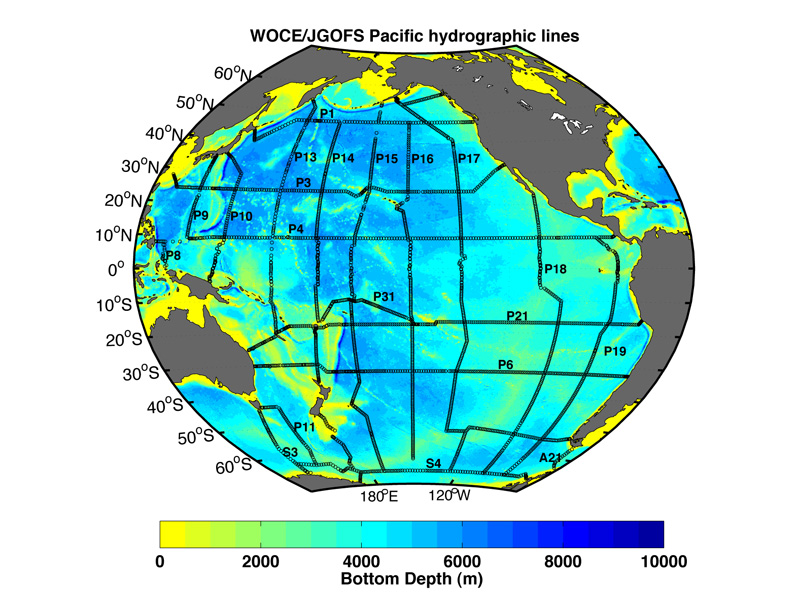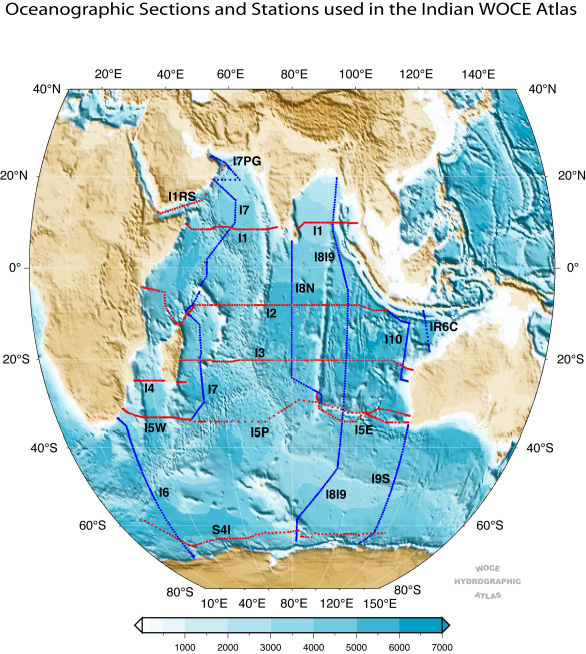Research Projects
A summary of my research projects is given below.
Fukishima Tracers
Following the Trail of Fukushima Tracers
Collaborators:
Ken Buesseler, Irina Rypina, Sachiko Yoshida, Steve Jayne
Summer student: David Fertitta
This project uses the unique information provided by the one-time, spring 2011, release of cesium and strontium radioisotopes from the Fukushima Nuclear Power Plant to better understand the pathways and mixing of water in the North Pacific Ocean. We look to combine recent radioisotope observations along 30N, 155W and other North Pacific Cs data, with hydrographic, satellite, drifter and float observations, and numerical model results to illuminate the details of the horizontal spread and vertical mixing that has taken place since the 2011 isotope release.
Pacific Carbon
Collaborative Research: Relating Estimates of Natural and Anthropogenic Carbon to the 3-Dimensional Circulation of the Pacific Ocean
Collaborators:
Sabine Mecking (APL/UW)
To predict the progression of CO2 increases in the atmosphere and the evolution of anthropogenic climate change a detailed, quantitative understanding of the interaction between ocean circulation and oceanic carbon sources and sinks is required. We hypothesize that abyssal flow into the Pacific Ocean represents a significant pathway for anthropogenic carbon entering the basin from the south to circulate into the deep North Pacific, while the shallow cell which crosses from the southern to the northern hemisphere supports a pathway for recently ventilated, and therefore carbon rich waters into the intermediate layers of the northern basin. Here, we propose to use the existing 3-dimensional Pacific circulation provided by a synthesis of WOCE hydrography together with JGOFS/OACES measured or derived total inorganic carbon values, pCO2 derived air-sea CO2 fluxes, and a variety of derived anthropogenic carbon estimates based on observations from the same time period to investigate the transport, divergence and air-sea flux of contemporary and anthropogenic carbon in the full Pacific Basin, and to compare these results to those from model and assimilation based studies, and pCO2 based estimates alone.
Indian Ocean Overturn and Mixing
Collaborative Research: Estimating the Indian Ocean overturn and diapycnal mixing
Collaborators:
Lynne Talley and Julie McClean
The Indian Ocean has multiple roles in the global overturning circulation and carbon cycle, including throughput and transformation of Indonesian Throughflow Water, upwelling of deep and bottom waters from the Atlantic and Southern Ocean, and diffusive production of deep, intermediate and thermocline waters fed by this upwelling. Decadal change in South Indian ventilation and upper ocean overturn has been demonstrated. We propose to:
(1) Improve estimates of the Indian Ocean overturning circulation and diapycnal mixing, and the associated carbon and nutrient budgets. Modern, comprehensive data analysis and a high resolution GCM will be used to interpret and narrow the wide range of current estimates.
(2) Characterize regional (east-west and basin-oriented) distributions of mixing and overturn, defined by the complex basin geometry, and forcing that is strongly variable in both space and time, and determine how these inhomogeneities impact carbon, anthropogenic carbon, oxygen, freshwater and heat transports and divergences.
(3) Analyze changes in overturning circulation at 32°S from 1987 through 2009. Compute mass, heat, freshwater, CO2, oxygen and nutrient budgets from the 32°S section being collected in spring 2009; compare with previous occupations, and analyze in light of changes in the wind and buoyancy forcing (including the Southern Annular Mode).
We are using three complementary approaches for estimating basin-wide circulation, overturn and mixing: (1) analysis of the Indian Ocean portion of two state estimates of the circulation, temperature and salinity (ECCO and the related high resolution SOSE); (2) analysis of the chemical and physical data from WOCE/JGOFS sections, and repeat sections at 32°S for 1987, 2002, (1995) and 2009 using inverse techniques; and (3) analysis of overturn and diapycnal mixing in the high resolution POP model, which has recently been run with tracers. The project will include analysis of the mean and the seasonal (monsoonal) circulation. Carbon transports will be compared to previous observation-based results and to the results from OCMIP models.


